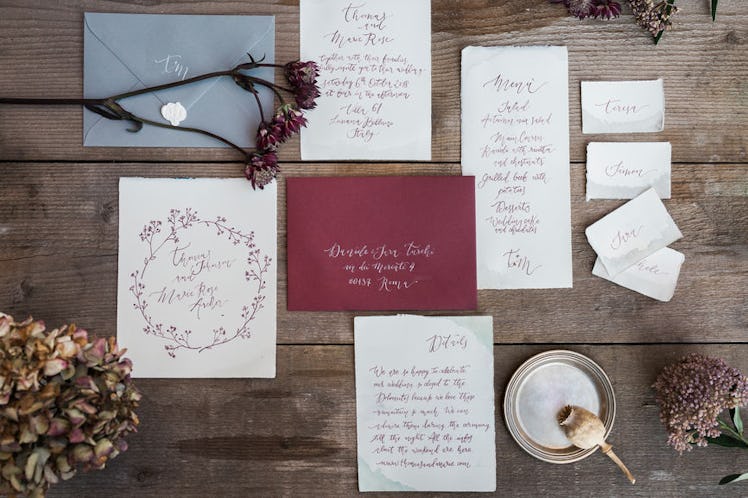
Here’s The Deal With Sending Wedding E-Vites Instead Of Printed Invitations, Because It’s Tricky
If you or someone you know has ever planned a wedding, then you how hard it can be. Whether or not you want to have a big wedding, elope, or throw a fun reception in your parents' backyard, it can be a lot when it comes to stress, time, and money. That being said, most couples end up looking for ways to save money and be more practical with wedding preparations. You can use greenery instead of flowers, for example, or cut corners in other ways. For instance, it's actually mostly OK to send wedding e-vites instead of paper invitations, although it depends on the situation.
"The pros of e-vites are time and cost," relationship and etiquette expert April Masini tells Elite Daily. "If you’ve got guests all over the world, foreign postage, a slow mail system and the chance that you’ve got a wrong address, meaning a delayed or aborted invitation, are all difficulties you face when sending paper invites. E-vites are quick and cheap."
In short, if you and your partner have a lot of guests but are short on time and money, e-vites might be the way to go. However, Masini also warns that "many people find them tacky."
Masini also says that it's important to remember that there is a clear difference between handwritten invitations and e-vites. "Well thought out, beautifully composed, engraved invitations that have hand calligraphy-addressed envelopes, and are sent in a mannerly timeline are the old school etiquette standard," Masini says. "E-vites may be modern, but they are not the height of etiquette. They are somewhere down that food chain."
If old school tradition is important to you, then perhaps it might be best to stick to paper wedding invitations. However, if you're having a smaller wedding, or are pressed for time, then e-vites can be helpful. Many wedding planning companies also offer free wedding websites for couples to organize their registries, wedding day details, and guest lists, and make it possible to keep everything online and digital. E-vites can totally be gorgeous and appropriate, but they aren't for everyone.
Finally, Masini explains that "It’s not really good etiquette to send e-vite wedding invitations because it implies a lack of commitment to the actual wedding." More, "The reason that traditionally, weddings are planned six to twelve months after the engagement is because they are important and the time between the engagement and the wedding is used to consider wedding options and plan them," Masini adds. "E-vites indicate that there is less planning and less thought put into the event. If you have a choice, send paper invitations. It’s better etiquette to send paper invitations than digital — even if it’s cheap paper with cheap printing. E-vites should be reserved for less formal occasions."
If you aren't having a formal wedding, you're short on time, or you have family all over the world, then send those e-vites! It's less stress and saves a lot of money. If you want to send formal invitations, but still want to keep your stress low, then send out paper invites but ask guests to RSVP online instead of paying for and sending out RSVP cards. It's easier for your guests, saves you money and time, but still follows the "etiquette" of paper invites. At the end of the day, your wedding is about you and your parter. Every decision, from the invitations to the champagne, is for you and your partner to make. Embrace that power, and if anyone has a problem with it, they don't have to come to your wedding! Easy as (very good, very expensive) wedding cake.